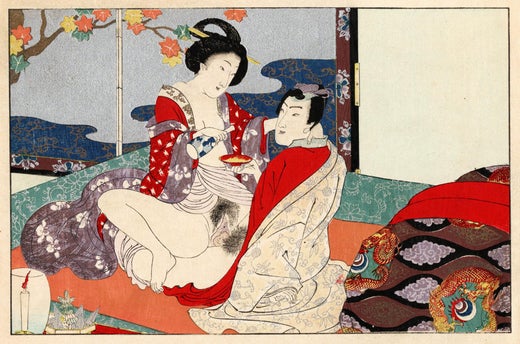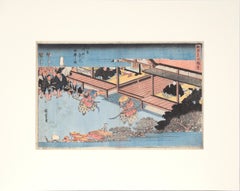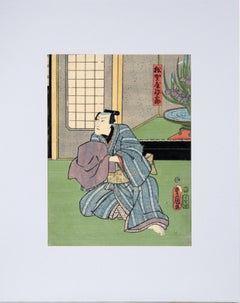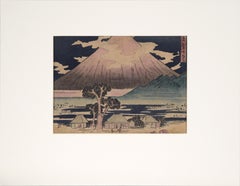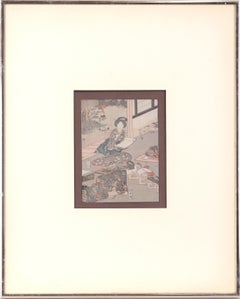Want more images or videos?
Request additional images or videos from the seller
1 of 12
Utagawa Kunisada (Toyokuni III)Dancer with Fan - Mid 19th Century Figurative Japanese Woodblock Print on Paper1834-1867
1834-1867
Price:$600
$680List Price
About the Item
- Creator:Utagawa Kunisada (Toyokuni III) (1786-1864, Japanese)
- Creation Year:1834-1867
- Dimensions:Height: 21 in (53.34 cm)Width: 16 in (40.64 cm)Depth: 0.25 in (6.35 mm)
- Medium:
- Movement & Style:
- Period:
- Condition:some minor age toning may be present to paper. Paper sheet may have been trimmed slightly.
- Gallery Location:Soquel, CA
- Reference Number:Seller: DBH83401stDibs: LU54211539292
Utagawa Kunisada (Toyokuni III)
Born in the Honjo district of Edo as Kunisada Tsunoda, Kunisada’s family owned a small hereditary ferryboat service. Though his father, an amateur poet, died when Kunisada was a child, the family business provided some financial security. During his childhood, he showed considerable promise in painting and drawing. Due to strong familial ties with literary and theatrical circles, he spent time studying actor portraits. At age 14, he was admitted to study under Toyokuni, head of the Utagawa school. Kunisada's work embodies the characteristics of the Utagawa school, focusing on traditional subjects such as kabuki, bijin (beautiful women), shunga (erotic prints), and historical prints. His first known print dates to 1807, his first illustrated book to 1808. Kunisada’s career took off from the beginning. Many of his works became overnight successes and he was considered the “star attraction†of the Utagawa school. He signed his works “Kunisada,†sometimes with the studio names of Gototei and Kochoro affixed. In 1844, he adopted the name of his teacher and became Toyokuni III. Kunisada passed away in 1864 in the same neighborhood that he was born. He was 70 years old. Kunis
About the Seller
5.0
Platinum Seller
Premium sellers with a 4.7+ rating and 24-hour response times
Established in 1986
1stDibs seller since 2014
3,043 sales on 1stDibs
Authenticity Guarantee
In the unlikely event there’s an issue with an item’s authenticity, contact us within 1 year for a full refund. DetailsMoney-Back Guarantee
If your item is not as described, is damaged in transit, or does not arrive, contact us within 7 days for a full refund. Details24-Hour Cancellation
You have a 24-hour grace period in which to reconsider your purchase, with no questions asked.Vetted Professional Sellers
Our world-class sellers must adhere to strict standards for service and quality, maintaining the integrity of our listings.Price-Match Guarantee
If you find that a seller listed the same item for a lower price elsewhere, we’ll match it.Trusted Global Delivery
Our best-in-class carrier network provides specialized shipping options worldwide, including custom delivery.You May Also Like
Seishi Ai-oi Genji – Set of 12 Shunga works together w/astrological commentary
By Utagawa Kunisada (Toyokuni III)
Located in Middletown, NY
Set of 12 woodblock prints in colors on handmade, laid mulberry paper, 6 3/4 x 10 1/4 inches (170 x 258 mm), printed in Ka-ei 4 (1851). Each print with minor handling wear, otherwise in excellent condition with bright and fresh color, and with details printed in silver ink. The images themselves contain several illusive characters indicating the publisher which are obfuscated by figures, as intended. Presented loose, as issued. A fine set.
The astrological commentary print has a large and meandering blind stamp with a bird and palm frond motif. This print lists various phrases concerning the Twelve Zodiac Animals as historically counted in Japan, and appears to include erotic commentary on the traits of people born under each of the twelve signs.
These Shunga images were issued in books that paralleled (in an erotic fashion...
Category
Mid-19th Century Edo Nude Prints
Materials
Ink, Handmade Paper, Woodcut
Japanese Beauties Enjoy a Full Moon
By Utagawa Kunisada (Toyokuni III)
Located in Burbank, CA
"Sun, Moon and Stars". Three beauties enjoy a full moon on the veranda of a teahouse or restuarant. The woman on the left kneels and adjusts her lavishly printed kimono. The beauty in the center has her hair down, and behind her is a screen against which shadows are beautifully silhouetted, which adds an air of mystery. The seated woman on the right is perhaps a geisha, as we see a shamisen lying next to her. Before her is a tray with an assortment of foods. One may surmise that the beauties are being compared to the sun, the moon, and the stars. On the left we glimpse a full moon shining over the peaceful bay, and boats at harbor. Original first edition Japanese color woodblock print triptych...
Category
1840s Edo Figurative Prints
Materials
Mulberry Paper, Woodcut
$3,600
H 14.18 in W 29.06 in
19th century color woodcut Japanese ukiyo-e print female geisha figure signed
By Utagawa Kuniyoshi
Located in Milwaukee, WI
This print is from a highly regarded series by the Edo woodblock artist Utagawa Kuniyoshi: in the period, there were at times prohibitions in depicting a...
Category
1850s Edo Figurative Prints
Materials
Pigment, Paper, Woodcut
Utagawa Kuniyoshi19th century color woodcut Japanese ukiyo-e print female geisha figure signed, 1852
$3,200 Sale Price
20% Off
H 21.5 in W 17.5 in
Black Horse
By Tokuriki Tomikichiro
Located in Middletown, NY
circa 1950.
Woodblock print in black and gray ink on Japon laid paper, 10 1/4 x 15 3/4 inches (260 x 398 mm), full margins. With the artist's embossed chop mark in red ink in the l...
Category
Mid-20th Century Edo Animal Prints
Materials
Handmade Paper, Woodcut
Plucking a Branch from a Neighbor's Plum Tree
By Suzuki (Hozumi) Harunobu
Located in Middletown, NY
A mischievous tableau with sexual overtones.
Tokyo: Shuei-Sha, 1768.
Woodblock print in colors printed on laid mulberry paper, 10 3/4 x 7 7/8 inches (273 x 200 mm), full margins. I...
Category
Mid-18th Century Edo Portrait Prints
Materials
Handmade Paper, Watercolor, Woodcut
$1,000
H 10.75 in W 7.88 in
Chrysanthemums and the Rising Moon
By Suzuki (Hozumi) Harunobu
Located in Middletown, NY
An image that originally appeared in an astrological calendar for the year 1766.
Tokyo: Shuei-Sha, 1766. Woodblock print in colors printed on laid mulberry paper, 10 3/4 x 7 7/8 in...
Category
Mid-18th Century Edo Still-life Prints
Materials
Watercolor, Handmade Paper, Woodcut
The Actors Nakajima Wadaemon as Bōdara Chōzaemon and Nakamura Konozō as Gon of t
Located in Middletown, NY
Two minor villains from "Medley of Tales of Revenge" square off, as performed at the Kiri theatre, Tokyo, in May of 1794.
Toyko: Tsutaya Juzaburo, 1794.
Woodblock (nishiki-e) with ...
Category
Late 18th Century Edo Portrait Prints
Materials
Watercolor, Handmade Paper, Woodcut
Toshogu Shrine
Located in Middletown, NY
In image of the Tokugawa family paying homage to Tosho-gu Shrine in Nikko.
Tokyo: Matsuki Heikichi, 1896
Woodcut in ink with embossing and hand-coloring in watercolor on handmade m...
Category
Late 19th Century Edo Figurative Prints
Materials
Watercolor, Handmade Paper, Woodcut
Two Women Playing Sugoroku from "Comparison of the Customs of Beauties."
Located in Middletown, NY
A scene from a vanishing Japan.
Two Women Playing Sugoroku from "Comparison of the Customs of Beauties."; The Customs and Manners of Women
Japan: Matsuki Heikichi, 1891.
Woodblock ...
Category
Late 19th Century Edo Figurative Prints
Materials
Watercolor, Handmade Paper, Woodcut
$450
H 12.75 in W 8.63 in
The Lonely House at Asajigahara.
Located in Middletown, NY
A scene from a series of ghost stories and spooky rural legends.
Tokyo: Matsuki Heikichi, 1896.
Woodcut in ink with embossing and hand-coloring in watercolor on handmade mulberry pa...
Category
Late 19th Century Edo Figurative Prints
Materials
Watercolor, Handmade Paper, Woodcut
More From This Seller
View AllSumiyoshi: Dengaku dance performed during an Onda ceremony - Woodblock Print
By Utagawa Hiroshige
Located in Soquel, CA
Sumiyoshi: Dengaku dance performed during an Onda ceremony - Woodblock Print
Bright woodblock print by Utagawa Hiroshige (Japanese, 1797-1858). In this scene, two dancers with swords and fans are facing each other, in the center of a courtyard. There are spectators surrounding them, including nobles in black clothing on a balcony.
Presented in a new off-white mat with foamcore backing.
Mat size: 16"H x 20"W
Paper size: 9.63"H x 14.5W"
Utagawa Hiroshige (1797-1858, sometimes called Ando Hiroshige) was the second of the two great masters of the Japanese landscape woodblock print...
Category
1830s Edo Figurative Prints
Materials
Ink, Rice Paper, Woodcut
"Sun Saburo Matsugaya" - Mid 19th Century Figurative Japanese Woodblock Print
By Utagawa Kunisada (Toyokuni III)
Located in Soquel, CA
"Sun Saburo Matsugaya" - Mid 19th Century Figurative Japanese Woodblock Print
Beautiful mid 19th century figural Japanese woodblock print of a seated man with lilies in the background by Utagawa Toyokuni III (Kunisada) (Japanese, 1786-1864/5). Artist's chop is in the lower right corner of the piece. The actor is Magosaburo Matsugaya from the play "Katakiuchi Rumors"
Presented in a new grey-blue mat with foamcore backing.
Mat size: 21"H x 16"W
Paper size: 14"H x 9.75"W
During his lifetime Kunisada Utagawa...
Category
1850s Edo Figurative Prints
Materials
Paper, Ink, Woodcut
Study of Utagawa Hiroshige's "View of Hara-Juku" 53 Stations of the Tokaido Road
By Utagawa Hiroshige
Located in Soquel, CA
Study of Utagawa Hiroshige's "View of Hara-Juku" 53 Stations of the Tokaido Road
Hand painted study of Utagawa Hiroshige's "View of Hara-Juku", (by unknown artist), from "53 Station...
Category
1920s Edo Landscape Prints
Materials
Paper, Ink, Woodcut
$380 Sale Price
20% Off
Scribe and Personal Assistant to the Shogun - Japanese Woodblock Print on Paper
Located in Soquel, CA
Scribe and Personal Assistant to the Shogun - Japanese Woodblock Print on Paper
Detailed woodblock print by an unknown artist, In the style of Suzuki Harunobu. There are two women i...
Category
19th Century Edo Figurative Prints
Materials
Paper, Ink, Woodcut
$920 Sale Price
20% Off
Elegant Amusements of Eastern Genji - Japanese Triptych Woodblock Print on Paper
By Utagawa Kunisada (Toyokuni III)
Located in Soquel, CA
Elegant Amusements of Eastern Genji - Japanese Triptych Woodblock Print on Paper
Dynamic woodblock print with several elegantly dressed figures by Utag...
Category
1850s Edo Figurative Prints
Materials
Paper, Ink, Woodcut
One Hundred Aspects of the Moon, Mt Otawa Moon - Bright God Tamura
By Tsukioka Yoshitoshi
Located in Soquel, CA
"Mount Otawa Moon: Bright God Tamura" - Woodblock on Paper by Tsukioka Yoshitoshi
From the series "One Hundred Aspects of the Moon"
This piece depicts the general Sakanoe no Tamura...
Category
1880s Edo Figurative Prints
Materials
Paper, Ink, Woodcut
